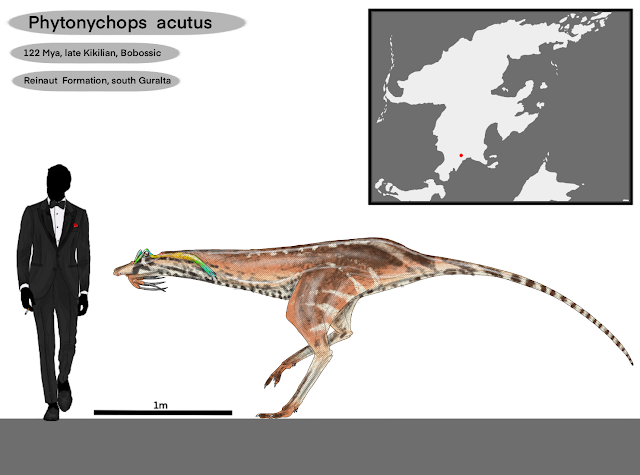A world so similar to our own, yet so fundamentally different. Abandoned by time, rediscovered by mankind. (Best viewed on desktop)
Tuesday, 13 May 2025
Reinaut Formation: Phytonychops
The Reinaut Formation in the south of the continent called Guralta is one of, if not the most extensive fossil site from the late Bobossic. Dated to have been formed between 125 and 122 million Eryobian years ago, the Reinaut Formation offers a glimpse of what life was like in the Kikilian, the latest stage of the Bobossic right before the devastating mass extinction dubbed “The World Scarring” happened.
Back when it was formed, the Reinaut Formation was likely a subtropical or temperate open woodland subject to seasonal rains. The fossils discovered in the Reinaut Formation so far, have mostly been megafaunal animals which tended to fossilise better than smaller animals in the conditions that were present in Reinaut 122 million years ago.
While not a true Kampourischiid itself, Phytonychops acutus was a close relative of the group that shared many of the same traits such as reduced visendal forelimbs, a hump on the hip and bipedal locomotion. What sets Phytonychops and its relatives apart from the Kampourischiids is the feet. Kampourischiids walked mostly on their first, second and third toes with the fourth and fifth toes being reduced or rudimentary. Phytonychops however, had toes more reminiscent of modern bidepal walkers like Stauropterygians. Walking mostly on the second, third and fourth toes with the first and fifth toes being reduced.
Judging by its teeth, Phytonychops was likely largely herbivorous, but would have occasionally added meat to its diet in the form of small animals, youngsters of larger creatures and perhaps carrion. It would’ve used its long caecal claws to strip leaves and bark from plants.
Due to the large number in which they have been found, it is believed that Phytonychops was a gregarious animal that lived in large flocks. Being a slender and fast animal, it likely wouldn’t have had much to fear from Onchometopos. Kampourischium however, would have been the main predator of Phytonychops as a number of the latters fossils with imbedded teeth from the former clearly indicate predation.
Subscribe to:
Post Comments (Atom)
-
Among modern Anisospondyls, there are few as diverse as the Eusymmetrodactyla. The bulk of their species and diversity comes from their flyi...
-
Modern Anisospondyls can be placed into one of three major categories. There are the Brachiostomata , a group which was apparently very dive...
-
Beneath the waves of Eryobis we can find a group of very strange looking animals, even for Eryobian standards. Occurring in habitats ranging...




No comments:
Post a Comment